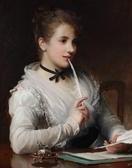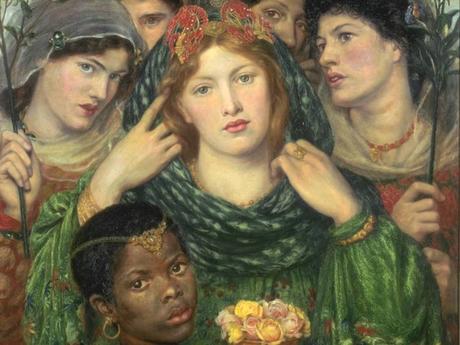
Dante Gabriel Rossetti, L'amata ( o La Sposa ), 1865 -1866, © Tate Galllery, London 2014
Nella londra di metà ottocento se si voleva comprare un cappello si doveva frequentare la zona intorno a Leicester Square. Le vie strette che erano Cranbourne Street, Cranbourne Alley e Cranbourne Passage erano i luoghi da visitare, pieni di modiste, sarte che confezionavano mantelli ed abiti. Le strade erano così strette, i negozi così numerosi e le vie così affollate che era difficile percorrerle senza ostacoli. Qualsiasi signora abbastanza ingenua da trovarsi in questo quartiere indossando un cappellino fuori moda o un mantello sarebbe stata inondata da una quantità esagerata di offerte di assistenza e numerose suppliche per acquistarne di nuovi, spesso accompagnate da risse animate dalle assistenti di negozi rivali. Ci sono stati casi di donne che hanno visto i loro abiti strappati o addirittura temporaneamente "rapiti" da ragazze così desiderose di vendere che cercavano di cogliere velocemente l'ingenuo viandante per condurlo nel loro negozio prima che qualche rivale potesse sopraggiungere. Alla fine degli anni 1840, il numero 3 di Cranbourne Street era una modisteria di proprietà di una certa signora Mary Tozer. Per aiutarla nel suo lavoro, la signora Tozer impiegava diverse ragazze e donne attraenti, che non solo confezionavano cappelli e lavoravano come commesse, ma potevano anche vestire il copricapo per mostrarlo al suo meglio delle sue potenzialità estetiche. Una di queste era una giovane donna di nome Elizabeth, o 'Lizzie' Siddall (più tardi il suo cognome fu mutato in Siddal) 1
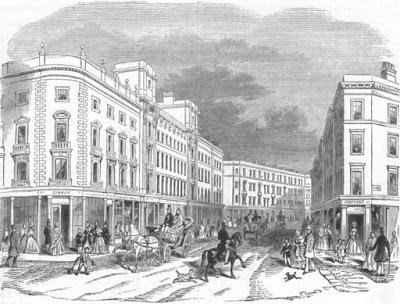
Cranbourne Streeet nel 1845
Comincia così la storia di Elizabeth Siddall, come una meravigliosa favola nella Londra del 1849: ella ha vent'anni, è di umili origini - seconda di otto fratelli - e lavora per 24 sterline l'anno nel retrobottega di una modisteria di Cranbourne Street, per l'esattezza proprio quella orgogliosamente gestita da Mrs.Tozer; individuata per caso dietro la vetrina della suddetta bottega dal pittore Walter Howell Deverell, astro nascente nel campo della pittura, vicino ai soci fondatori della confraternita artistica dei Pre-Raffaelliti, appena costituitasi e perciò non ancora conosciuta, che occasionalmente si trovava a passare per quei luoghi, fu da lui immediatamente notata poiché egli vide in lei la modella perfetta per il suo ritratto the Twelfth Night ispirato alla omonima commedia Shakespeariana
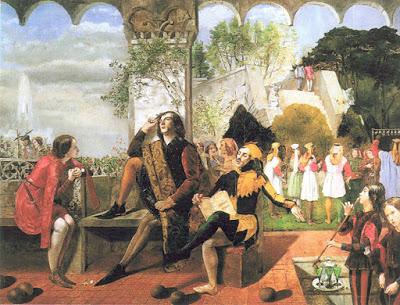
... beh, è vero che ella aveva i capelli rossi, che al tempo non solo non aderivano ai canoni femminili della bellezza, ma ancora si facevano portatori di sinistre superstizioni ( e pensate che proprio grazie a lei e al prestigio che in tale caratteristica lessero gli artisti della confraternita Pre-Raffaellita che il loro significato verrà 'ribaltato' al punto da divenire essi sinonimo di sensualità ), ma era di corporatura slanciata e snella e perciò aveva tutte le caratteristiche necessarie per rappresentare Viola nei panni maschili di Cesario, il paggio del Duca Orsino.
Ma leggiamo ciò che più tardi Holman Hunt scrisse circa la prima volta che sentì parlare di Elizabeth Siddall:
A quel tempo Rossetti aveva l'abitudine di venire da me con un foglio di disegno, di sedersi con esso progettando qualcosa mentre io stavo dipingendo in un'altra parte della stanza ... Deverell interruppe le nostre pacifiche fatiche. Non era stato seduto molti minuti, a parlare in maniera un po' assente, quando salì, in marcia, o meglio ballando su e giù per la stanza, e, fermandosi enfaticamente, sussurrò: " Voi compagni non riesco a dirvi quale creatura stupendamente bella ho trovato. Per Giove ! E 'come una regina, magnificamente alto, con una bella figura, un collo maestoso, ed un viso dalle fattezze più delicate e rifinite, la cui superficie dalle tempie alle guance è esattamente come quello di una scultura di una dea Fidiana ... mi sono rivolto a mia madre perchè convincesse quella creatura miracolosa a posare per me per la mia Viola in 'La dodicesima notte', e oggi ho cercato di dipingerla, ma ho cominciato facendo un pasticcio. Domani tornerà e voi due dovreste venire giù per vederla, è davvero una meraviglia, perché mentre i suoi amici, naturalmente, sono molto umili, lei si comporta come una vera signora, dal palese buon senso e senza affettazione, sapendo perfettamente, anche, come mantenere le persone a rispettosa distanza." 2
Al vederla posare, immediatamente, prima Rossetti, poi lo stesso Holman Hunt, la vollero anche loro come modella, leggevano negli occhi semplici che accendevano di luce quel volto scarno la devozione e la scintilla della passione che stava nascendo in lei per Deverell, passione peraltro reciproca, da che spesso il pittore s'innamora della propria modella; Rossetti, traduttore, scrittore, pittore passionale e dal carattere volubile, volle subito quella donna tutta per sé ... e la ottenne !
Per lui ella divenne l'incarnazione della Beatrice dantesca, della Ginevra arturiana, del simbolo stesso dell'amore ... Dante ( egli amava mettere in risalto le proprie origini italiane e perciò preferiva anteporre il primo nome, peraltro altisonante, al secondo, Gabriel, inglese ) ed Elizabeth si conobbero nel 1849-50, proprio nell'occasione appena descritta, e nonostante ella fosse infatuata di Deverell, egli riuscì a coinvolgerla in un legame passionale senza pari che la avvinghiò a lui e la rese da lui totalmente dipendente, nonostante i tradimenti che le fece tollerare e soffrire, per il resto della sua seppur breve vita.
Divenuta la modella della confraternita ella dapprincipio divideva il proprio tempo tra le numerose pose per questi pittori dalle tecniche innovatrici, che avevano riscoperto il valore della luce, ed il proprio lavoro presso il negozio, sotto gli occhi straripanti di gelosia del suo amante; poi, con il tempo, divenendo il lavoro intenso ed estenuante, ella lasciò la modisteria per divenire una modella a tutto tondo e per dedicarsi ella stessa all'arte, quella della poesia e del disegno che ci rivelano, seppur nella semplicità delle origini e dell'educazione ricevuta, una finezza d'animo particolarmente inconsueta.
E' datato 1852 il dipinto Ophelia di Millais che segnò indelebilmente la vita di Lizzie, come amava chiamarla Rossetti, sia da un punto di vista artistico, poiché da allora la sua fama andrà a consolidarsi definitivamente, sia da un punto di vista fisico, poiché da allora la sua salute comincerà inevitabilmente a vacillare: Millais cercò di dipingere sul suo volto come meglio poteva, l'espressione della donna sofferente, e vi riuscì mirabilmente anche perché Lizzie sofferente lo era davvero, e molto:
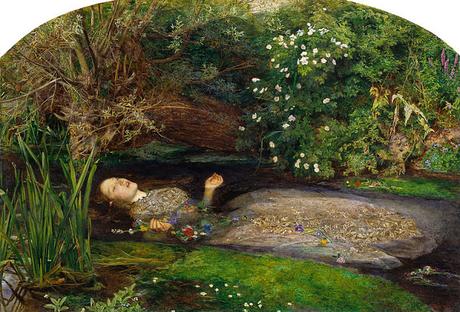
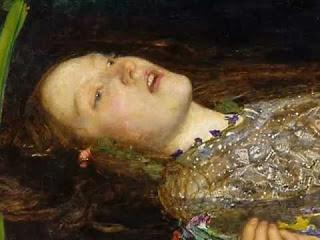
La signorina Siddal ebbe un'esperienza del tutto sperimentale, quando posò quale modella per Ofelia. Affinché l'artista potesse ottenere l'immagine appropriata degli indumenti in acqua e la giusta atmosfera e l'effetto acquoso, ella doveva trovarsi in un grande vasca piena d'acqua, che era mantenuta ad una giusta temperatura da lampade posto sotto. Un giorno, proprio quando il dipinto era quasi finito, le luci si spensero senza che l'artista, così intensamente assorto nel suo lavoro tanto da non pensare a null'altro, se ne accorgesse, e la povera signora rimase a galleggiare nell'acqua fredda fino a che fu quasi intorpidita. Ella non si lamnetava, ma il risultato fu che contrasse una forma di bronchite e suo padre scrisse a Millais, minacciandolo con un ricorso di £ 50 per la sua disattenzione. Alla fine la questione si risolse quando Millais decise di pagare la fattura del medico; e Miss Siddal, recuperando in fretta, non riportò danni alla sua salute per il suo bagno freddo. 3
Per quanto riguarda il dipinto, i due angoli superiori smussati ci rivelano che Lizzie fu fatta posare dentro una vasca posta in un baldacchino imperiale: sappiamo che fu realizzato in due tempi, uno per la posa della modella, immersa in acqua abbigliata con un abito da sposa rinascimentale, ed uno per la 'realizzazione' del ruscello ( John Everett Millais si trasferì per un certo tempo in campagna, lungo le rive dell'Hogsmill River dove poté studiarne con cura la vegetazione per dipingerla con rigore scientifico: nel dipinto compaiono infatti piante quali l'olmaria, le margherite, il salice, il papavero e l'ortica, assunte a simboli di morte, dolore ed innocenza già nello stesso Amleto ).
Nel novembre del 1852 Rossetti, che ancora dimorava con la propria famiglia insieme con tutti i fratelli, Christina, William e Maria, decise che fosse per lui giunto il momento di farsi una vita indipendente, avendo anche superato i vent'anni di età, e chiedendo l'appoggio del fratello minore, l'unico che poteva garantire denaro con il proprio lavoro all'intera famiglia, andò a vivere in un piccolo appartamento di soli due vani al n.14 di Clatham Place, Blackfriars, Londra, portando con sé quella che era divenuta la sua modella e la sua alunna, ma furono in pochi a non credere che ella fosse innanzitutto la sua amante, avendo inoltre l'appartamento una sola stanza da letto.
Cominciò così per Lizzie l'idillio, ovvero, ciò che ella pensava fosse un idillio, ma che presto divenne sinonimo di tormento, palese concretazione della dicotomia Eros - Thanatos, Amore - Morte, da che sovente questo ardore era amareggiato dalla mancanza di una proposta di matrimonio, da separazioni, cui facevano seguito angosce abbandoniche, da riconciliazioni, spesso costellate da relazioni che, fugacemente nascevano e altrettanto fugacemente morivano, ma che sempre più aggravavano il suo stato di salute: ella soffriva di disturbi alimentari, quella che oggi chiameremmo anoressia, e, non essendo al tempo riconosciuta e doverosamente curata, le veniva prescritto del laudano, un composto in grado, allora, si credeva, di curare ogni male, essendo dato da una soluzione alcoolica di oppio, reperibile presso qualsiasi negozio, poiché le farmacie ancora non esistevano;
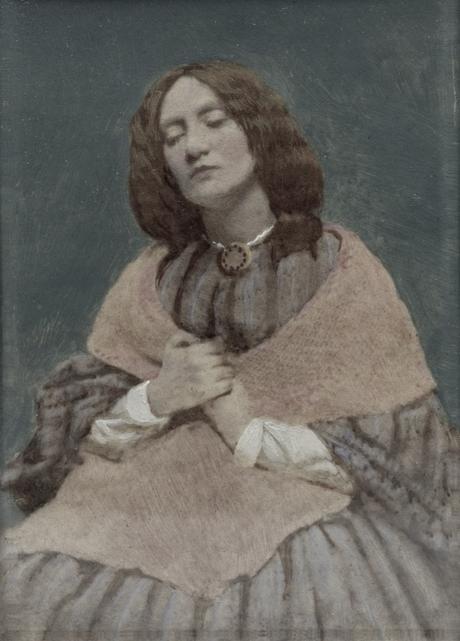 Lizzie in un ritratto di Julia Margaret Cameron del 1860ben comprenderete come, perciò, come quello che allora veniva genericamente definito come disturbo alimentare, nato su base depressiva, verrà sempre più accentuato dalla dipendenza dall'alcool e dalla droga di cui il laudano era composto, tanto da indurla a periodi di vera inedia, soprattutto quando si trovava in casa sola ad attendere il ritorno al nido del suo amato.
Lizzie in un ritratto di Julia Margaret Cameron del 1860ben comprenderete come, perciò, come quello che allora veniva genericamente definito come disturbo alimentare, nato su base depressiva, verrà sempre più accentuato dalla dipendenza dall'alcool e dalla droga di cui il laudano era composto, tanto da indurla a periodi di vera inedia, soprattutto quando si trovava in casa sola ad attendere il ritorno al nido del suo amato.Ma Lizzie non doveva soffrire di un siffatto male, pari ad un male inguaribile, un male fatto d'amore e di sogni traditi, ella era davvero molto bella - era la prima delle modelle dei Pre-Raffaelliti e rimase per sempre la più femminile e la più graziosa - la gente s'innamorava di lei e dei suoi modi al solo guardarla, le uniche che non riuscirà mai a conquistare saranno le sorelle Rossetti e la loro madre, la signora Frances Polidori Rossetti, possessive, gelose, di mentalità molto chiusa, che avrebbero preferito per il loro Gabriel una donna di origini italiane e di un rango se non superiore, almeno pari al loro, non una donna di tali umili natali, per giunta con i capelli rossi, che erano per loro sinonimo di una natura corrotta, capace di 'traviare' il loro Gabriel che già aveva loro portato via d'in casa.
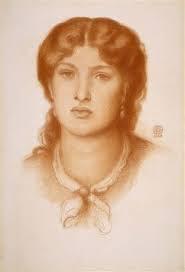 Lizzie ritratta da Rossetti negli anni del loro idillioQuando egli nel 1855 decise di presentarla alla famiglia dell'amico Ruskin, appena conosciuto, ma subito stimato, da poco divorziato da Euphemia Gray in uno scandalo che scosse l'intera Londra ( Link ) tutti, Mrs Margaret Ruskin inclusa, videro in lei una donna di alti costumi, di un'inusitata grazia nei movimenti e nel sentire, dai modi degni di una contessa, ma nonostante anche questi cercarono di convincerlo a convolare a nozze con lei, lui, pur atossicato da questo morbo fatto passione, di dipendenza, quasi di vassallaggio amoroso senza possibilità di scampo che lo induceva a ritrarre nessun'altra altre che non fosse lei, nei più disparati atteggiamenti e pose,
Lizzie ritratta da Rossetti negli anni del loro idillioQuando egli nel 1855 decise di presentarla alla famiglia dell'amico Ruskin, appena conosciuto, ma subito stimato, da poco divorziato da Euphemia Gray in uno scandalo che scosse l'intera Londra ( Link ) tutti, Mrs Margaret Ruskin inclusa, videro in lei una donna di alti costumi, di un'inusitata grazia nei movimenti e nel sentire, dai modi degni di una contessa, ma nonostante anche questi cercarono di convincerlo a convolare a nozze con lei, lui, pur atossicato da questo morbo fatto passione, di dipendenza, quasi di vassallaggio amoroso senza possibilità di scampo che lo induceva a ritrarre nessun'altra altre che non fosse lei, nei più disparati atteggiamenti e pose, 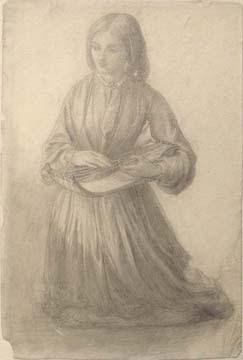
Elizabeth Siddal playing the Cythern, 1852
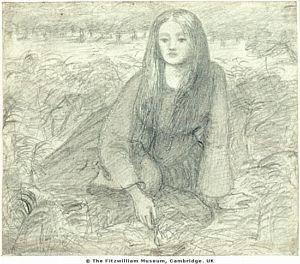
Elizabeth Eleanor Siddal - A drawer full of Guggum*, December 1853
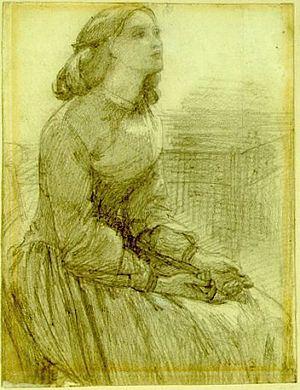
Dante Gabriel Rossetti, studio per Beata Beatrix, 1854
egli non riuscì a decidersi a maritare quella che da anni definiva la sua colomba, 'his dove' - e Lizzie da quel momento siglerà le proprie opere pittoriche proprio con l'effigie della colomba - mentre per Ruskin, che immediatamente decise di divenirne il mecenate leggendo nella sua arte un notevole talento, divenne subito 'Ida', dal nome dell'eroina del poema di Alfred Lord Tennyson, The Princess .
Anche se malata Lizzie continuava ad essere bellissima, con i suoi magnifici capelli di rame, con il suo corpo perfetto, slanciato, per cui gli artisti della Londra Vittoriana avevano fatto follie; viaggiò infatti molto per motivi di salute e quando finalmente il suo Dante il 23 maggio del 1860 decise di maritarla, ella aveva alle proprie spalle già molte delusioni che altro non avevano fatto che ridurla miseramente.
L'evento che fu decisivo per la sua esistenza fu il dare alla luce, l'anno successivo, un bimbo nato morto ( probabilmente anche la dipendenza dal laudano giocò in questo un ruolo determinante ), episodio che segnò indelebilmente la sua già fragile personalità, tanto che poco dopo Rossetti la trovò nel suo letto priva di vita; malgrado il referto medico parlasse di "morte accidentale", dovuta cioè ad un'errata valutazione della dose di laudano da assumere, Rossetti capì che si trattava di suicidio - il suicidio, all'epoca, oltre ad essere considerato immorale era anche illegale: lo scandalo avrebbe travolto tutta la famiglia di Rossetti e alla Siddal sarebbe stata negata la sepoltura in terra consacrata; va inoltre detto che al tempo era nuovamente incinta e potrebbe anche essere stata spinta al suicidio dal non aver sentito più muovere il feto nel suo grembo - e, dopo essersi confidato con l'amico pittore Ford Madox Brown, decise di dare alle fiamme la lettera d'addio della sua Lizzie che ella gli aveva lasciata.
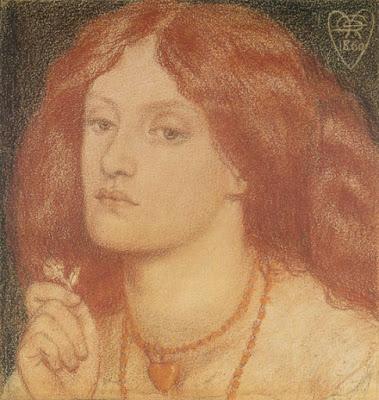 Regina Cordium ( The Queen of Hearts ), Dante Gabriel Rossetti, 1860
Regina Cordium ( The Queen of Hearts ), Dante Gabriel Rossetti, 1860La più affascinante di tutte le muse, la regina di cuori dei Pre-Raffaelliti, con la sua aurea chioma che la avvolgeva come una sacra 'mandorla' - così era chiamato l'alone di luce delle icone bizantine - che posò per opere che rimarranno per sempre nel tempo quali l'Ophelia di Millais, che la eternerà inequivocabilmente come mai nessuna modella prima, né dopo, aveva tristemente chiuso gli occhi su questa vita l'11 febbraio del 1862.
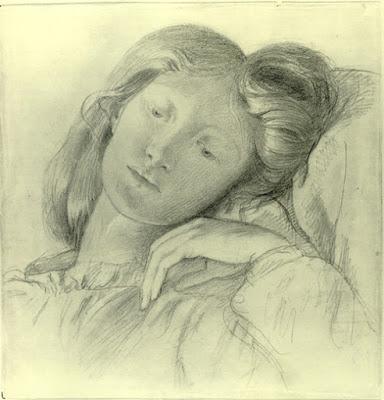
Schizzo di Dante Gabriel Rossetti degli anni '50 dell'ottocentoNella tomba, insieme al corpo di Lizzie, Rossetti fece porre anche l'unica copia dei manoscritti d'amore che egli stesso le aveva dedicato, scritti nel corso degli anni: il quaderno che li conteneva venne infilato fra i suoi capelli rossi che lo custodirono fino a quando nel 1869 egli, sempre più fiaccato dall'abuso di alcool e droga e persuaso di essere prossimo alla cecità, fu ossessionato dal desiderio di pubblicare le proprie poesie accompagnate da quelle della moglie.... chissà che nelle sue interminabili notti solinghe, trascorse nella piccola, umida dimora che era stato il nido d'amore di Dante e Beatrice egli non avvertisse il rimpianto per l'amata che aveva perduto e che per anni aveva tradito e disilluso ... non esisteva nessuna che potesse prendere anche in parte, il suo posto nel suo cuore, né Jane Burdem, futura Jane Morris, né Fanny Cornforth, con le quali, entrambe, ebbe importanti relazioni amorose ... egli sosteneva di essere perseguitato dal fantasma di Lizzie non appena chiudeva i propri occhi e perciò fu indotto a cambiare abitazione, ma ancora non trovò sollievo da questo suo stato depressivo.
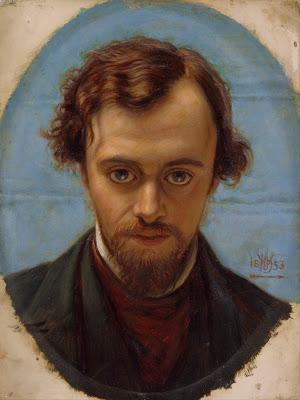
Dante Gabriel Rossetti all'età di 22 anni in un ritratto di Holman Hunt
Insieme con il proprio agente Charles Augustus Howell, egli ottenne il permesso di aprire la tomba di Lizzie per recuperare il quaderno di poesie: il tutto venne svolto di notte, per evitare lo sdegno della gente, unici testimoni furono la luce della luna e quella di un falò, acceso perché la tomba si trovava in un luogo piuttosto buio del cimitero, per evitare lo sdegno della gente.Dante non ebbe il coraggio di presenziare ed attese a casa dell'amico Howell il quale raccontò che il corpo della Siddal aveva mantenuto intatta la propria bellezza, e che i suoi ramati capelli avevano continuato a crescerle a dismisura per giungere a colmare per intero la bara che accoglieva le sue spoglie ... ovviamente non si tratta di qualcosa di verosimile, ma forse contribuì, al tempo, ad alimentare l'immagine quasi mitizzata o divinizzata di colei che venne chiamata 'modella' prima ancora che il termine fosse coniato.
E così quella che era cominciata con i toni ed i presupposti di una bellissima favola si concluse come una tragedia shakespeariana delle più classiche ... da che il suo corpo, lasso e senza vita, similemente a quello di Ophelia, fu trascinato via dalle correnti della passione ...
Vi lascio citando una poesia che ella scrisse qualche giorno prima della sua dipartita:
ITAToccare il guanto sulla tenera mano,Per guardare il luccichio della gemma nel suo anello,Sollevò il mio cuore in un canto improvvisoCome quando gli uccelli selvatici odo cantare.Toccare la sua ombra sul prato assolato,Per rompere il suo percorso attraverso il bosco buio,Colmò tutta la mia vita con tremore e lacrimeE di silenzio dove mi trovavo.Guardo le ombre che si radunano intorno al mio cuore,Io vivo per sapere che ella è ita -Ita, ita per sempre, come la tenera colomba Che ha lasciato da sola l'Arca. 4
E vi prego, perdonatemi se è una storia non a lieto fine, ma di storia si tratta, e soprattutto della storia di un personaggio e di un momento fondante il periodo vittoriano da cui non si può prescindere, sia artisticamente che culturalmente;
vi abbraccio quindi teneramente augurandovi ogni bene e ringraziandovi, sempre
a presto ♥


Bibliografia:
Lucinda Hawksley, Lizzie Siddal: The Tragedy of a Pre-Raphaelite Supermodel, Andre Deutsch Ltd, 2008;
Jenny Ridd, A Destiny Defined: Dante Gabriel Rossetti and Elizabeth Siddal in Hastings, Edgerton Publishing Services, 2008.
Citazioni e note:* Guggum era un termine vezzeggiativo che avevano coniato loro e che usavano quando si rivolgevano l'uno all'altro;
1 - Lucinda Hawksley, Lizzie Siddal: The Tragedy of a Pre-Raphaelite Supermodel, Andre Deutsch Ltd, 2008, pag. 1;
2 - Ibidem, pag. 22;
3 - Ibidem, pag. 42-3;
4 - Ibidem, pag. 212.

In mid-nineteenth-century London, if you wanted to buy a hat, you would have made your way to the area around Leicester Square. The narrow throughfares that were Cranbourne Street, Cranbourne Alley and Cranbourne Passage were the places to go, crammed with milliners, mantle-makers and dressmakers. The streets were so narrow, the shops so numerous and the roads so crowded that it was difficult to pass along them unimpeded. Any lady naive enough to find herself in this district while wearing an unfashionable bonnet or cloak would be swamped by over-whelming offers of assistance and numerous entreaties to buy a new one, often accompanied by tussles over the potential customer by rival shops' assistants. There were incidences of women having their clothes ripped or even being temporarily "kidnapped" by over-eager salesgirls who would seize the witless wanderer and hurry her into their shop before any rival snapped her up. In the late 1840s, 3 Cranbourne Street was a hat shop, owned by a Mrs Mary Tozer. To hel her in the business, Mrs Tozer employed several attractive girls and woman, who not only made the hat and worked as shop assistants but could also model the headgear to its best advantage. One of these was a young woman named Elizabeth, or 'Lizzie' Siddall ( later changed to Siddal ). 1
- picture 2
Thus the story of Elizabeth Eleanor Siddal begins, as a wonderful fairy tale, in London of the year 1849: she is twenty years old, is of humble origins - the second of eight children - and works for 24 pounds a year in the back room of a millinery in Cranbourne Street, to be exact that very proudly managed by Mrs Tozer; seen by chance behind the window of the aforementioned workshop by the painter Walter Deverell, a rising star in the field of painting, close to the founders of the artistic Pre-Raphaelite Brotherhood, just constituted and therefore not yet known, whom occasionally happened to be passing by those places, he was immediately hit by her for he saw her as the perfect model for his portrayal of the 'Twelfth Night' inspired by the homonymous Shakespeare's comedy
- picture 3
... Well, it's true that she had red hair, which at the time not only didn't adhere to the canons of female beauty, but still were bearers of sinister superstitions (and think that just thanks to her and the prestige that in such a singular characteristic read the Pre-Raphaelite brotherhood of artists, their meaning will be 'flipped' to the point that they become synonymous of sensuality), but she was of slender build and willowy and therefore had all the necessary features to represent Viola in the male role of Cesario, Duke Orsino's page.
But let's read what later Holman Hunt will write about the first time he heard about Elizabeth Siddall:
Rossetti at that date had the habit of coming to me with a drawing folio, and sitting with it designing while I was painting at a further part of the room ... Deverell broke in upon our peaceful labours. He had not been seated many minutes, talking in a somewhat absent manner, when he bounded up, marching, or rather dancing to and fro about the room, and, stopping emphatically, he whispered, " You fellows can't tell what a stupendously beautiful creature I have found. By Jove ! She's like a queen, magnificently tall, with a lovely figure, a stately neck, and a face of the most delicate and finished modelling; the flow of surface from the temples over the cheek is exactly like the carving of a Phiydean goddess ... I got my mother to persuade the miracolous creature to sit for me for my Viola in 'Twelfth Night', and to-day I have been trying to paint her; but I have made a mess of my beginning. To-morrow she's coming again; you two should come down and see her; she's really a wonder; for while her friends, of course, are quite humble, she behaves likes a real lady, by clear commonsense and without any affectation, knowing perfectly, too, how to keep people respectful at a distance. 2
To see her sitting, immediately, Rossetti first, and then Holman Hunt, also wanted her to model for them, they read in her simple eyes that lit that gaunt face the devotion and the spark of passion that was growing into her for Deverell, passion, however, mutual, which is quite common between the painter and his model; Rossetti, translator, writer, passionate painter by fickle nature, immediately wanted that woman all to himself ... and won!
For him, she became the incarnation of Dante's Beatrice, of the Arthurian Geneva, of the symbol of love and passion themselves.
Dante (he loved to emphasize his Italian origins and therefore preferred to precede his first name, Gabriel, by the second, so high-sounding) and Elizabeth met in 1849-50, just in the occasion described above, and although she was infatuated of Deverell, he managed to involve her in a passionate bond unparalleled that linked her to him and made her totally dependent, despite the betrayals that he'll made her endure and for which she'll suffer for the rest of her life, albeit brief.
Became the model of the brotherhood, she at first divided her time between the many poses for these painters by the innovative techniques - actually they had rediscovered the value of light - and her work at the store, under the eyes overflowing with jealousy of her lover; then, with time, becoming the work harder and exhausting, she left the millinery to become a full time model and to devote herself to art, painting, poetry and design which revealed, despite the simplicity of her origins and of her 'upbringing, a subtlety of mind particularly unusual.
It's dated 1852 the painting 'Ophelia' by Sir john Everett Millais which indelibly marked Lizzie's life, putting her, ad a divinity in the Heaven of art, both from an artistic point of view, because since then her reputation will definitively consolidate, putting her, ad a divinity in the Heaven of art , and from a physical point of view because since then her health will inevitably begin even frailer: Millais tried to paint on her face the expression of the suffering woman as best as he could, and he succeeded admirably also because Lizzie was really suffering ... and a lot:
- picture 4
- picture 5
Miss Siddal had a trying experience whilst acting as a model for Ophelia. In order that the artist might get the proper set of the garments in water and the right atmosphere and acqueous effect, she had to lie in a large bath filled with water, which was kept at an even temperature by lamps placed beneath. One day, just as the picture was nearly finished, the lamps went out unnoticed by the artist who was so intensely absorbed in his work that he thought nothing else, and the poor lady was kept floating in the cold water till she was quite benumbed. She herself never complained of this, but the result was that she contracted a severe cold, and her father wrote to Millais, threatening him with an action for £50 for his carelessness. Eventually the matter was satisfactorily compromised. Millais paid the doctor's bill; and Miss Siddal, quicly recovering, was none the worse for her cold bath. 3
As for the painting, the two rounded top corners reveal that Lizzie was made to lay in a bathtub placed in an imperial canopy and we know it was deployed in two stages, one for the laying of the model, immersed in water clothed with a Renaissance bride dress, and one for the 'realization' of the stream (John Everett Millais moved for a time in the country, along the banks of the Hogsmill River where he could study carefully its vegetation, as to paint it with scientific precision: in fact in this painting appear plants such as meadowsweet, daisies, willow, poppy and nettles, assumed to symbols of death, pain and innocence already in the same Hamlet).
In November of 1852 Rossetti, who still lived with his family along with all his siblings, Christina, William and Mary, decided it was time for him to get an independent life, having also passed twenty years of age, and, after asking the support of the younger brother, the only one who could guarantee money with his work to the whole family, went to live in a small apartment of only two rooms at the nr.14 of Clatham Place, Blackfriars, London, bringing with him what had become his model and his pupil, but they were few those who didn't believe that she was the first of his mistress, also because the little flat had only one bedroom.
Thus began for Lizzie the idyll, or what she thought it was an idyll, but which soon became synonymous with agony, the overt concretazione of the dichotomy Eros - Thanatos, Love - Death, for this ardor was often embittered by the lack of a proposal of marriage, by separations, followed by anguish of abandonment, by reconciliations, often studded by relationships that, fleetingly were born and fleetingly died, but which more and more aggravated her frale state of health: she suffered from an eating disorder, what we now call anorexia, and, not being at that time recognized and dutifully cared, she was prescribed laudanum, a compound capable, it was believed then, to cure every ill, being given to an alcoholic solution of opium, available at any store, for pharmacies did not exist yet;
- picture 6 - Lizzie in a portrait by Julia Margaret Cameron, 1860
as you can well understand, therefore, what was then loosely defined as an eating disorder, was born on the basis of a deep depression, which will increasingly become worse by dependence on alcohol and drugs with which laudanum was made, much to induce her to periods of actual starvation, especially when she was in the house alone to await the return of his beloved to their the nest.
But Lizzie did not have to suffer from such an evil equal to an incurable evil, an evil due to love and betrayed dreams, she was very nice - it was the first of the models of the Pre-Raphaelites and will remain for ever the most feminine and the prettiest - people fell in love with her and her ways just at looking at her, the only ones that she'll never conquer werre the Rossetti sisters and their mother, Mrs. Frances Polidori Rossetti, possessive, jealous, very closed-minded, who would have preferred for their Gabriel a woman of Italian origin and coming from a rank if not more, at least equal to theirs, not a woman of such humble roots, furthermore with red hair, who were for them synonymous with a corrupt nature, able to 'entice' their Gabriel, whom was already taken away from their home.
- picture 7 - Lizzie portrayed by Rossetti in the years of their idyll
When in 1855 he decided to introduce her to the family of his new friend Ruskin, just met, but soon estimated, recently divorced from Euphemia Gray in a scandal that shook the whole London (Link) everyone, including Mrs Margaret Ruskin, saw in her a woman of high morals, of an unusual grace of movement and feeling, manners worthy of a countess, but despite them also tried to convince him to get married to her, he, even if 'poisoned' by this disease made of love and passion, a sort of addiction, almost vassal loving with no possibility of escape which led him to portray any other that wasn't her, in many different poses and attitudes,
- picture 8 - Elizabeth Siddal playing the Cythern, 1852
- picture 9 - Elizabeth Eleanor Siddal - A drawer full of Guggum *, December 1853
- picture 10 - Dante Gabriel Rossetti, study for Beata Beatrix, 1854
was unable to bring herself to marry the one who, for years, he called his 'Dove' - and since that moment Lizzie will sign her paintings just with the image of the dove - and for Ruskin, who immediately decided to become her patron as son as he saw her talented art, she immediately became Ida, named after the heroine of the poem by Alfred Lord Tennyson, "The Princess"
Although sick Lizzie was still very beautiful, with her magnificent copper hair, with her perfect body, slender, for which so many artists of the Victorian London had follies; in fact, she traveled a lot for health reasons and when finally her Dante on May 23th, 1860 decided to marry her, she had already behind her so many disappointments, that did nothing but reduce her miserably.
The event that was decisive for her existence was to give birth, the following year, to a stillborn baby-girl ( possibly laudanum addiction played a decisive role in this ), an episode that indelibly marked her already fragile personality, so much so that shortly after Rossetti found her lifeless in her bed; despite the medical report spoke of "accidental death", due to an incorrect evaluation of the dose of laudanum to be taken, Rossetti knew it was suicide - suicide, at the time, besides being considered immoral was also illegal: the scandal would have overwhelmed the family of Rossetti and the poor lizzie was denied to be buried in consecrated ground; it must be added that she was also pregnant, and maybe she was push to the suicide feeling her baby not moving anymore - and, having confided in his friend, the painter Ford Madox Brown, he decided to set fire to the farewell letter his Lizzie had left him.
- picture 11 - Regina Cordium (The Queen of Hearts), Dante Gabriel Rossetti, 1860
The most fascinating of all the muses, the queen of hearts of the Pre-Raphaelites, with her golden hair that wrapped her like a sacred 'almond' - so it was called the halo of light of the Byzantine icons - who posed for works that will remain forever in time such as 'Opheli'a by Millais, which will unequivocally eternalize her as no model before, and nor after her, had sadly left this life the 11th February, 1862.
- picture 12 - Sketch by Dante Gabriel Rossetti of the mid XIXth century
In the grave, along with the body of Lizzie, Rossetti placed also the only copy of the manuscript of the love compositiona that he himself had dedicated her, written along the years: the notebook that contained them was stuck between her red hair that guarded it until the year 1869, when he increasingly weakened by the abuse of alcohol and drugs and persuaded to be next to blindness, was obsessed by the desire to publish his poems, accompanied by those of her wife ... I wonder if in his lonely, endless nights spent in the small, damp house that was the love nest of Dante and Beatrice, he didn't feel something like a regret for the loved one who lost and who, for years had betrayed and disillusioned ... there was none that could take, even in part, her place in his heart, neither Jane Burdem, future Jane Morris, nor Fanny Cornforth, with whom, both, hwe had quite important love affairs ... he claimed to be haunted by the ghost of Lizzie as soon as he closed his eyes and so he was led to change dwelling, but still found no relief from this depressive state of his.
Together with his agent Charles Augustus Howell, he obtained the permission to open Lizzie's grave to retrieve the book of poetry: everything was done at night, to avoid the wrath of the people, the only witnesses were the light of the moon and that of a bonfire, lit because the tomb was in a rather dark place of the cemetery.
- picture 13 - Dante Gabriel Rossetti portrayed at the age of 22 by Holman Hunt.
Dante lacked of courage, so waited at Howell's house, who told that the body of Siddal had maintained her beauty, and that her auburn hair had continued to grow out of proportion to reach to fill the entire coffin welcoming her remains ... of course this is not something realistic, but perhaps contributed, at the time, to feed the mythologized or perhaps almost deified image of her who was called 'model' even before the term was coined.
I'm leaving you quoting a poem that she wrote a few days before her departure:
GONE
To touch the glove upon her tender hand,To watch the jewel sparkle in her ring,Lifted my heart into a sudden songAs when the wild birds sing.To touch her shadow on the sunny grass,To break her pathway through the darkened wood,Filled all my life with trembling and tearsAnd silence where I stood.I watch the shadows gather round my heart,I live to know that she is gone -Gone gone for ever, like the tender doveThat left the Ark alone. 4
And please forgive me if this is s not a story with a happy ending, but it's story, and above all the story of a character and of a founding moment of the Victorian period which cannot be ignored, both artistically and culturally;
I embrace you so dearly wishing you all the best, with gratitude
see you soon ♥


Bibliography :
Lucinda Hawksley, Lizzie Siddal: The Tragedy of a Pre-Raphaelite Supermodel, Andre Deutsch Ltd, 2008;
Jenny Ridd, A Destiny Defined: Dante Gabriel Rossetti and Elizabeth Siddal in Hastings, Edgerton Publishing Services, 2008.
Quotations and notes:* Guggum was a term of endearment that they had coined for themseves and they used when they talked one another;
1 - Lucinda Hawksley, Lizzie Siddal: The Tragedy of a Pre-Raphaelite Supermodel, Andre Deutsch Ltd, 2008, p. 1;
2 - Ibidem, p. 22;
3 - Ibidem, pp. 42-3;
4 - Ibidem, p. 212.
